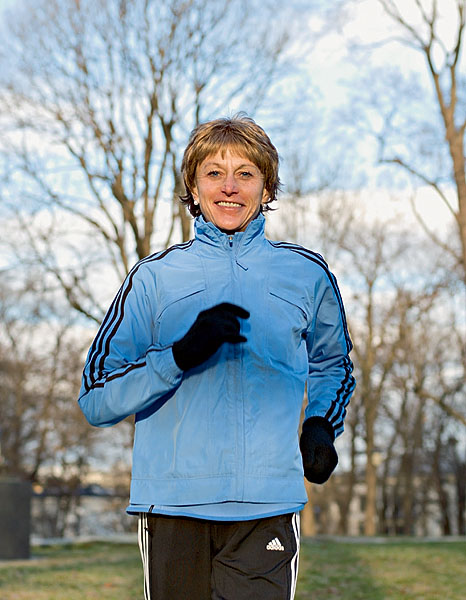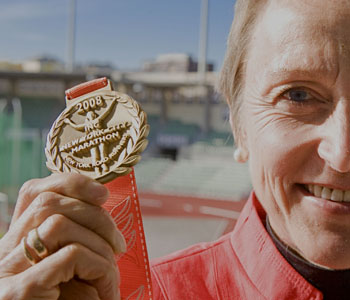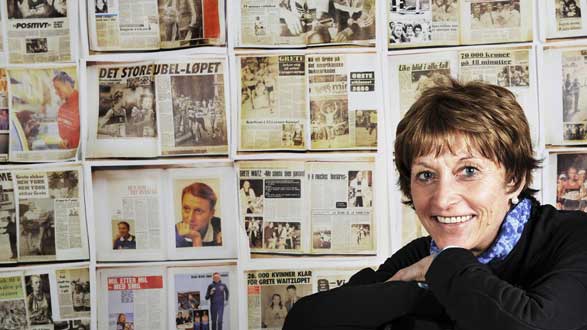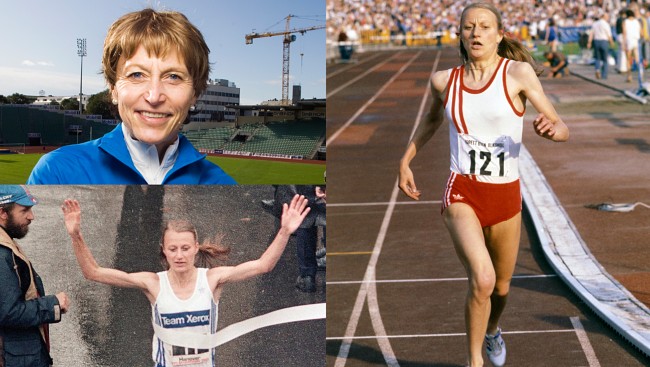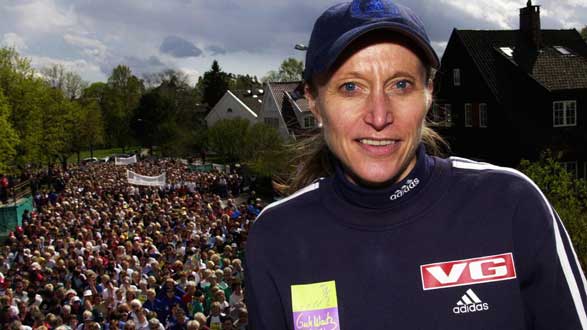‘We Should Treasure Every Mile’
Remembering Grete Waitz, The Greatest—At Everything
‘She was able to balance a competitive career with the most gracious lifestyle, and a character that emanated good will’
By David McGee
New York City has a special relationship with its Marathon winners, male and female, its residents turning out in the thousands to line the streets of the five boroughs and cheer on the participants, whether they be the inspiring, physically challenged athletes of the Achilles Club who are first into Central Park, or the elite runners at the front of the rest of the pack, or those fighting the good fight in bringing up the rear. In turn, the Marathon winners have almost universally comported themselves with dignity in the aftermath of their big wins, enhancing the good vibe suffusing the city on Marathon day.
In 2008, each NYC Marathon finisher was presented a medal bearing Waitz’s likeness and the inscription: ‘Grete Waitz--The Greatest Champion in New York City Marathon History.’ (Photo: Espen Solli)Of all these great winners, though, none was greater or more beloved, or a better example to others, than the Norwegian school teacher-turned-world class marathoner Grete Waitz, who did not merely win the New York City Marathon but dominated it like no other runner has--nine triumphs in all (1978-1980, 1982-1986, 1988), including five consecutive in one amazing stretch in the ‘80s. Grete Waitz, though, was distinguished less by her first-place finishes in Central Park than by her humility in victory, and her integrity and humanity on and off the course. When news came on April 19 of her death from cancer at age 57, a pall settled on the great city. Everyone, it seemed, athlete or not, sports fan or not, felt, and keenly, the loss of Grete Waitz, whose tenacity, toughness and unflagging work ethic made her not only a quintessential New York success story, but a beloved member of our urban family. Skeptics of this assertion take note: in 2008, each Marathon finisher was presented a medal bearing Waitz’s likeness and the inscription: “Grete Waitz--The Greatest Champion in New York City Marathon History.”
Great Moments in NYC Marathon History: profile of Grete WaitzOn the other hand, Grete Waitz was bigger than New York. She preached her message of physical fitness to the world, not to a single city. When she was diagnosed with cancer, she started a cancer care foundation, Active Against Cancer (Aktiv Mot Kreft), and arranged with her former main sponsor, Adidas, to contribute to it five percent of the proceeds from the sale of the company’s Grete Waitz and Modern Classics collections. This could be as much as NOK 500 million per year, which goes toward the establishment of hospital physical training centers and investment in PET-scanners. “I am convinced you can go through a lot more when you are physically fit,” Waitz explained of her foundation’s philosophy. “It is both physical and mental. With the athletic background, you think more on the positive side--you can do this.”
Grete crossing the finish line in 1978, completing her first New York City Marathon and her first New York City Marathon triumph. Saying she had been in complete agony during the last 10 miles of the race, upon crossing the finish line as the victor, she ripped off her running shoes and threw them at her husband, who was also her trainer, yelling, ‘I’ll never do this stupid thing again!’With her New York City Marathon triumphs mounting, Grete and her husband, Jack, became more involved in city life, and especially with the New York Road Runners Club, founded by Fred Lebow, who had started the New York City Marathon. Aware of Grete’s accomplishments as a member of the Norwegian national track team, Lebow invited her to run in the 1978 New York City Marathon, even though she was not a distance runner--she had never run more than 13 miles in any competition. Her husband, who was also her coach, was convinced Grete was marathon material, and urged her to run the NYC Marathon, if only so the couple could treat the event and the trip to Manhattan as something of a second honeymoon, although Grete later recalled in an interview that she saw it as an opportunity to celebrate her retirement from competitive running. Looking back at her first Marathon, she told various interviewers of being in complete agony in the race’s final 10 miles. When she crossed the finish line--note that she did finish, agony or no--she was so angry at Jack that she ripped off her running shoes and threw them at him, yelling, “I’ll never do this stupid thing again!”
This, after setting a world record of two hours, 32 minutes, 30 seconds, a global standard she lowered three more times in her career. She also won the London Marathon twice, the Stockholm Marathon once and the world championship marathon in 1983.
In 1979, she won her second NYC Marathon with a time of 2:27:33, beating her previous record by almost five minutes and becoming the first woman to officially run a marathon faster than two and a half hours. She was, instantly, a welcome sight on the course, tight-lipped, intensely focused on the moment, her blonde pigtails bouncing rhythmically at the back of her head; finally, after breaking through the tape at the finish line and gathering herself (there were no more shoe throwing incidents observed after her 1978 Marathon), a warm, shy smile would light up her friendly Scandinavian features. She exuded class.
If New York City loved Grete, she loved the city in return. Working with the New York Road Runners Foundation, she frequently spoke to schoolchildren, and often appeared on behalf of Fred’s Team, the cancer charity started by Fred Lebow. Each October the NYRR Club sponsors a half-marathon run called Grete’s Great Gallop.
Grete accompanying cancer-stricken New York City Marathon founder Fred Lebow in the 1994 Marathon. Running and walking side by side the entire distance, the couple finished the course in five-and-a-half-hours. Grete counted it as her tenth NYC Marathon victory. Amby Burfoot, the 1968 Boston Marathon winner and then editor at large for Runner’s World magazine, described Waitz and Lebow crossing the finish line as ‘the New York City Marathon’s most emotional moment.’Grete liked to correct those who remarked on her nine Marathon triumphs by saying she had in fact won ten such races: among her triumphs she counted the 1992 Marathon that she ran--and walked--with Lebow, whose brain cancer had gone into remission. She stayed at Lebow’s side through the entire race, looking, said Amby Burfoot, the 1968 Boston Marathon winner and editor at large for Runner’s World magazine, “pained indeed at times over their slow pace, (but) she ran and walked every step of the way with (him). Their hand-in-hand finish--after more than five-and-a-half hours on the course--next to Tavern On the Green will forever be the New York City Marathon’s most emotional moment.”
“It was an incredibly emotional day for both of us,” Waitz recalled in a later interview. “He gave me the strength to run, but it was very hard to run so slowly with him for more than five hours.”
In her native Norway, Grete Waitz has long been regarded as a national hero. A statue of her stands outside Bislett Stadium, an international sports arena in Oslo, and her likeness appeared on a Norwegian postage stamp. She established a 5-kilometer race in Oslo that eventually expanded to 40,000 runners, and in 2007, she started her foundation. In 2008 King Harald V bestowed upon her the Royal Norwegian Order of St. Olav, First Class, in recognition of being an important role model.
Emerging at a time when women were hardly even represented in competitive running, she effected a huge revolution in the sport, from the highest professional levels to the smallest amateur athletic events all over the world. It’s not a stretch to say that her impact on the culture at large warrants regarding her as the greatest female athlete of our time, whose example continues to inspire women and girls everywhere who love sports and want to participate--Grete opened the door for them all in a way other important female athletes preceding her could not.
“The women's running revolution, the biggest sea change in our sport in 30 years, began in Norway, where a young track star, Grete Waitz, broke boundaries as well as records,” Amby Burfoot wrote in Runner’s World in 200r. “In 1972, at the Munich Olympics, she ran the 1,500 meters, the first time women were allowed to participate in the event. She went on to win the New York City Marathon an almost inconceivable nine times, a feat achieved by no other runner (male or female), and set three world records.”
Grete discusses her partnership with Adidas in her foundation, Active Against Cancer, and how running helped her get her life back after her diagnosis and sedentary ‘recovery’ period.“Young people today have few heroes that they can truly look up to. Grete Waitz was one of those heroes,” noted sportscaster/author/executive producer Ann Liguori in a Huffington Post blog of April 19. “People of all ages were inspired by her determination, her guts, the way she broke down barriers for female athletes, showing that women could run longer distances. She worked tirelessly to promote the sport and fitness to others. And when she was diagnosed with cancer, she fought it in her own private way, never wanting the attention to be on her, creating a foundation to help others.”
Appropriately enough, her obituary began on the front page of the April 19 edition of one of her adopted home town newspapers, The New York Times. Written by Liz Robbins and Bruce Weber, the obit acknowledged Waitz’s pioneer status. “At the time of her first New York victory, women’s distance running was a novelty. Just 938 out of 8,937 entrants in the 1978 New York marathon were women--in 2010, 16,253 of 45,350 entrants were--and the women’s marathon would not be added to the Olympics until the 1984 Summer Games in Los Angeles, where Waitz finished second to Joan Benoit Samuelson.”
Samuelson, who told the Times she had “lost a mentor and a role model” with Waitz’s passing, observed: “What will endure forever is that she was able to balance a competitive career with the most gracious lifestyle, and a character that emanated good will.”
Few female runners have as complete a resume as Grete Waitz. Her career spans all of running's disciplines, from track and cross-country to road racing and marathoning, and she excelled at them all, winning 33 Norwegian championships. Svein Arne, head of the Norwegian athletics federation, called Waitz “the greatest Norwegian athlete of all times.”
Waitz grew up in Oslo, Norway. Through her teen years she won national junior titles in the 400 and 800 meters. At age 17, she set the European junior record in the 1,500 meters with a time of 4:17. In 1974, Waitz won a bronze medal at the European Championships at the metric mile distance.
The next year, Waitz raced the 3,000 meters and set a world record with a time of 8:46.6. By the end of 1975, Waitz was ranked number one in the world in both the 1,500 and 3,000. In 1977, Waitz won a gold medal in the 3,000 meters in the inaugural World Cup meet.
The grace and charm of one champion to another: Grete and three-time NYC Marathon winner Paula Radcliffe share a pre-Marathon press conference. Grete recounts how she was once mistaken for Paula and calls that ‘the biggest compliment I have ever gotten. I’m really proud someone thought I was Paula Radcliffe.’Even after becoming a dominant marathoner, Waitz continued to compete in track and cross-country and won five world cross-country championships. In 1984, she competed in the first women's marathon in the Olympic Games. She took home a silver medal for Norway. After retiring from running, she remained active in the running community as a spokeswomen for Avon Running--Global Women's Circuit and for Adidas. For her influence on American running in the United States, Waitz was the first foreign runner inducted into the National Distance Running Hall of Fame.
Grete Andersen was born in Oslo on Oct. 1, 1953. Her father, John, was a pharmacist; her mother, Reidun, worked in a grocery store. From an early age, she would run with her two older brothers, Jan and Arild, in a nearby forest and later at a local track club. She met Jack Waitz, a local track coach and an accountant for a newspaper, through mutual friends. Waitz was in her mid-20s, a geography teacher in the Oslo schools and the oldest woman on the Norwegian national track team when the invitation to participate in the marathon came from Lebow. At the time of Lebow’s invitation, she had been planning to retire from running after the 1978 track season to concentrate on teaching.
She is survived by her husband and her brothers.
***
Grete Waitz in Her Own Words
From www.thebiofile.com by Scoop Malinowski
Hobbies/Leisure Activities: “Before I was a professional runner I was a school teacher. So, running 110 miles a week, having a full time job as a schoolteacher, I didn’t really have time for a hobby. But in the last 5-10 years I’ve been involved in getting people to be aware of the importance of being active. Because inactivity is our biggest health threat. I’m motivating young people, adults, to be more active in their daily life.”
First Marathon Memory: “My first New York City Marathon in 1978 here in New York. It was terrible even though I won it and set the world best. I crossed the finish line and said, Never again. Because I was a track runner, a world class middle-distance runner. I was talked into running the marathon by my husband. I didn’t come into the race being prepared as a marathoner because I didn’t have the long runs. I had to pay for that. I couldn’t walk for the next three days.”
People Qualities She Most Admires: “What I like to see is generosity. If you have the chance to give back to your community, if you are in a position that you can give something back, I like to see people do that. Being generous.”
***
‘I Will Always See Those Pigtails’
In his Footloose column at the Runner’s World website, editor at large Amby Burfoot, the first journalist to interview Ms. Waitz after her initial NYC Marathon victory, offers a moving remembrance of the great athlete. He recalled visiting her in Oslo a year after her first NYC Marathon triumph. It was mid-winter, she was teaching during the days, training in her spare time--not in warm weather countries such as Australia and New Zealand, he noted, but “running hill repeats on an ice-slick sidewalk beside a busy thoroughfare.” Burfoot noted Ms. Waitz’s impeccable timing in passing away not on the day of but on the day after this year’s Boston Marathon. Writes Burfoot:
This morning, when I told my wife that Grete had died, she said: "That's typical that she waited until Tuesday. She probably didn't want to detract from the excitement of the races yesterday." So true.
Grete had such a long, wonderful career that we all have hundreds of memories of her. When I close my eyes, I see her pigtails swishing rhythmically like a metronome as she churned up First Avenue in New York. I think I will always see those pigtails.
Grete Waitz was a pioneer, a pacesetter, a pathmaker. We cannot make too much of what she contributed to our sport. She gave and gave and gave, and asked nothing in return.
Or maybe just this: That we should treasure every mile.
***
‘I enjoyed the sport, the distance, and the spirit. It was a passion for me.’
An Interview with Grete Waitz
By Rachel Wallack
Norwegian marathoner Grete Waitz got her start in track and cross country. She was a junior national champion at the 400, 800, and 1500 meters. She set a world record in 1975 with 8:46.6 in the 3000. But the marathon was Waitz’s path to stardom, in spite of her initial discomfort in the spotlight. She awed the world with her winning performances in New York in 1978-80, 1982-86, and 1988.
Waitz won the IAAF World Cross Country Championships five times, the Peachtree Road Race 10K four times, and the NYRR New York Mini Marathon five times. The gold medalist at the inaugural 1983 IAAF World Championships Marathon and the silver medalist in the first women’s marathon, at the 1984 Olympic Games, she’s more than just a champion, she’s a hero; Waitz has inspired many, including the children who run with the NYRRF, of which she’s the chairwoman.
Waitz, in NYC for the celebration of NYRR’s 50th anniversary, talked to New York Road Runners about her experiences.
New York Road Runners: What inspired you to start running in the first place--before you even thought about doing a marathon?
Grete Waitz: I was just a young girl, and I enjoyed running. I didn’t even think about it as a sport. We were playing--playing was synonymous with all outdoor activities. Running laps around the house and around the block was where it started.
NYRR: What was the breakthrough for you? How did you make the transition from a playful activity to a career?
GW: I got a little bit older, and I became a member of a track and field club--in the European club system--and I enjoyed the sport, the distance, and the spirit. It was a passion for me.
NYRR: How did you make people pay attention to you back then? I imagine it was tough to be a runner and even tougher to be a female runner.
GW: We’ve come a long way in a very short time. When I got a little older, I wasn’t encouraged to do sports--it wasn’t what girls should be doing. Even in the media, women didn’t get the same attention. We had to be twice as good. I had to set world records to get noticed.
NYRR: Did your New York City Marathon 1978 win really keep you in the sport and deter you from retiring from running?
GW: Yes, I came to New York with my husband to celebrate my retirement. I left for New York determined to continue my teaching and maybe have kids. But, instead, I quit my job teaching and never had kids. I always got excited when I came to New York for the marathon. Winning was a highlight each and every time.
NYRR: What do you think the New York Road Runners Foundation is doing to improve the sport today? What has been your motivation to get involved with NYRRF?
GW: When I was their age, I wasn’t any good at running. I was a mid-pack runner. I didn’t excel at the sport until I was a teenager. One of my passions now is to get the kids involved. It meant so much to me as a kid and as a girl. It’s really nice to pass it on.
Grete speaks as part of the Women@Google series, June 12, 2007 at Google headquarters in Mountain View, CA. She recounts her first NYC Marathon experience, her running career and health and fitness as a lifestyle. Two years earlier she had been diagnosed with cancer.
Founder/Publisher/Editor: David McGee
Contributing Editors: Billy Altman, Laura Fissinger, Christopher Hill, Derk Richardson
Logo Design: John Mendelsohn (www.johnmendelsohn.com)
Website Design: Kieran McGee (www.kieranmcgee.com)
Staff Photographers: Audrey Harrod (Louisville, KY; www.flickr.com/audreyharrod), Alicia Zappier (New York)
E-mail: [email protected]
Mailing Address: David McGee, 201 W. 85 St.—5B, New York, NY 10024


